Students add modern twist to medievalists’ meeting, forced online by COVID-19
Poster sessions became "fabulous, thought-provoking and visually great" videos, professor raves
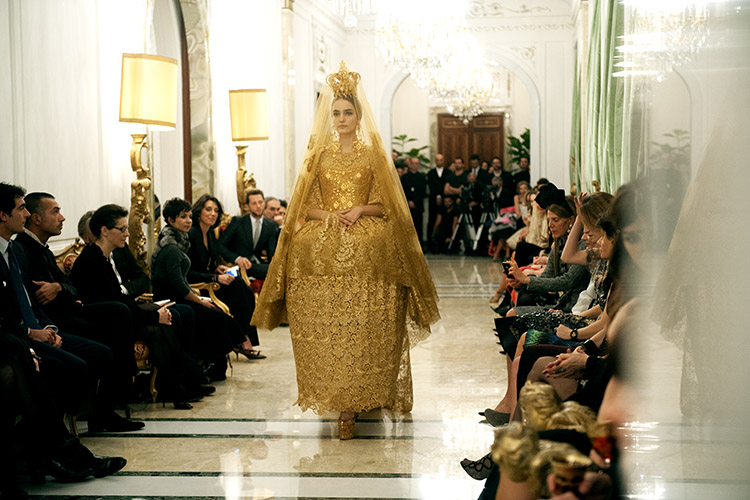
March 30, 2020
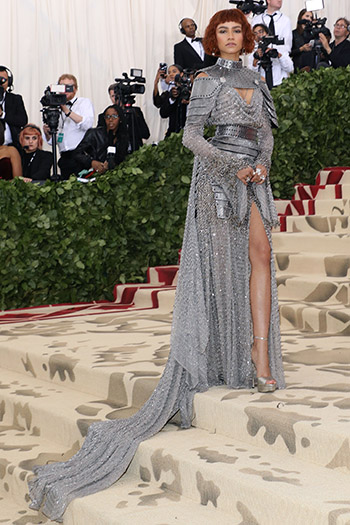
The American actress Zendaya wears the Joan of Arc gown by Donatella Versace that Dorian Cole, a sophomore, analyzed in a video project. Here, the garment is worn at the 2018 Costume Institute Benefit at the Met in May 2018. (Photo by Taylor Hill/Getty Images)
The UC Berkeley freshman and sophomore seminar was wildly popular, just like the Metropolitan Museum of Art of New York City (Met) exhibit it explored. Taught in fall 2019, Professor Maureen Miller’s students analyzed “Heavenly Bodies: Fashion and the Catholic Imagination,” a Met blockbuster that in 2018 drew a record crowd of nearly 1.7 million to see opulent haute couture inspired by the Catholic tradition.
When the course ended, sophomore Dorian Cole thought her final paper — on how a metallic Joan of Arc gown by Donatella Versace, worn at the 2018 Met Gala by Hollywood star Zendaya, engages with Catholicism — would simply become a grade.
Instead, Cole and former classmate Emily Su were invited by Miller to create poster sessions on their papers — Su’s was on an Alexander McQueen creation inspired by the 1440s Altarpiece of the Patron Saints of Cologne by Stefan Lochner — for the 95th annual meeting of the Medieval Academy of America. The conference was to be hosted last week (March 27-28) on campus by Berkeley’s Program in Medieval Studies.
Then came COVID-19, and the meeting turned virtual. No poster sessions needed. The papers, lectures and discussions would take place via Zoom.
“I was bummed,” said Su, a sophomore majoring in economics and history. (She’d gotten more bad news: The 2020 National Collegiate Table Tennis championships were off, due to the pandemic; Su plays on Berkeley’s top-ranked women’s club team).

Dorian Cole, here with her dog, Angel, in Oxnard, California, came up with the idea for turning her semester paper on Versace’s Joan of Arc dress into a video when COVID-19 forced the Medieval Academy of America’s 95th conference online. (Photo by Paula Nelson)
But Cole, who’s double-majoring in history and English and said she likes to make “little video essays” as a hobby, approached Miller.
“I said, ‘What if we made videos instead?’ and she said, ‘Yeah, do it!” said Cole. The videos, one by Cole, the other by Su, quickly joined the program, which included topics like “Dark Age Jesus,” “Peacocks, Natural Philosophy and the Edible Art of Altering Nature” and “What Did the Medieval Laity Hear When They Heard Latin?”
Cole and Su “already were going to be heroes over spring break, doing poster presentations,” said Miller, an expert on medieval religious beliefs and practices, “but instead they just ran with the idea of videos for the virtual conference and developed their projects in unusual ways. Presentations among us academics can be on the dull side, and theirs were fabulous and thought-provoking and visually great.”
“It makes me wonder,” she added, “if my future students could do video versions instead of final papers.”
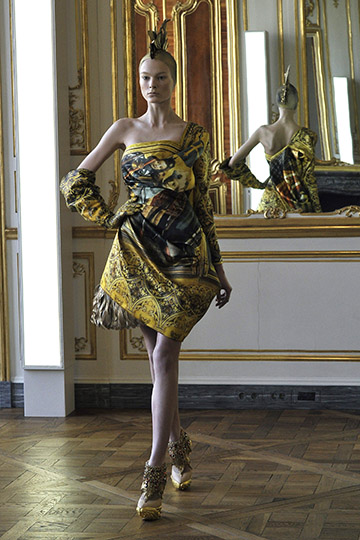
The dress that sophomore Emily Su wrote about, by Alexander McQueen, was displayed at the Met’s 2018 “Heavenly Bodies” exhibit. Here, it’s worn by a model during Paris Fashion Week in March 2010. (Photo by Chris Moore/Catwalking/Getty Images)
Miller’s fall 2019 seminar was prompted by the Met exhibit because, although stunning, “Heavenly Bodies” sparked controversy and criticism for being “all style, but no substance,” said Cole. Scholars felt the exhibit didn’t explain how these designers drew upon medieval Christianity to create clothing that engaged and commented on the world today.
Miller went to New York City to see the exhibit and agreed that it presented “incredible outfits, but insufficient information about them, and the catalog was equally insipid.”
The exhibit and catalog also were insensitive, she said, since Catholic priest sex abuses cases were a spiraling crisis in 2018. “There were garments displayed that I thought would be really traumatizing to anyone who’d been abused by a cleric,” she said, describing a series based on priests’ garb where one robe was suggestively open down the front, and another had a peephole at the crotch. Accompanying verbiage referred to the garments as “playful,” she said.
Miller asked her students to choose a garment, or a collection of garments, from the exhibit and then guided them through research and analysis of key issues, including the designers’ background, ideas and work, and the meanings evoked in the exhibit by the garments’ juxtaposition with medieval and Byzantine works of art.
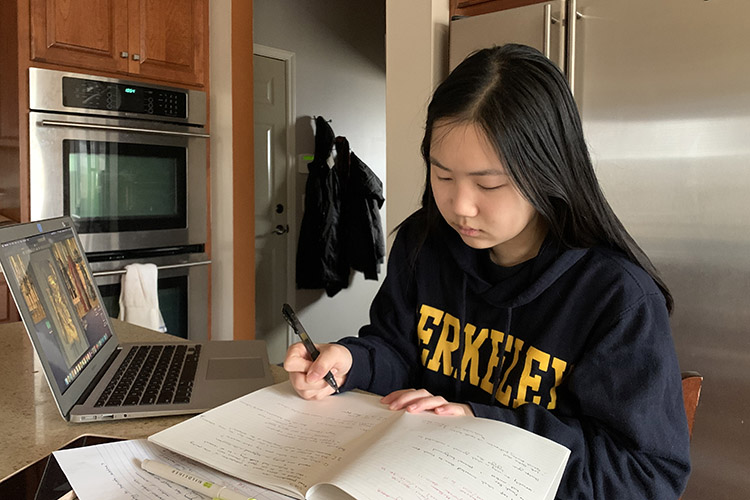
Emily Su, now home in Minnesota, took history professor Maureen Miller’s seminar on the Met’s “Heavenly Bodies” exhibit. Turning her semester paper into a video for the 95th annual meeting of the Medieval Academy of America helped her learn to “display certain things that wouldn’t come through in other forms,” she said. (Photo by Ashley Su)
Su said she chose “the Lochner dress” by Alexander McQueen since it “really caught my eye” and was one of the few garments with paintings on it. It also was detached at the Met from its symbolic meaning and its connections to the personal life of Lee Alexander McQueen, who committed suicide in 2010, said Su. In her video, “Alexander McQueen’s Lochner Dress: Changing Identities and the Heavenly Bodies Exhibit,” Su used existing footage from the exhibit and discussed the inspiration that the British fashion designer and couturier drew from Catholicism, Gothic art and life and death. She also explored the different presentations of the dress when worn on the catwalk by a human model — with a falconer’s glove and shoes with talon details — and on a mannequin at the Met, where attention was diverted from the dress to a nearby altarpiece.
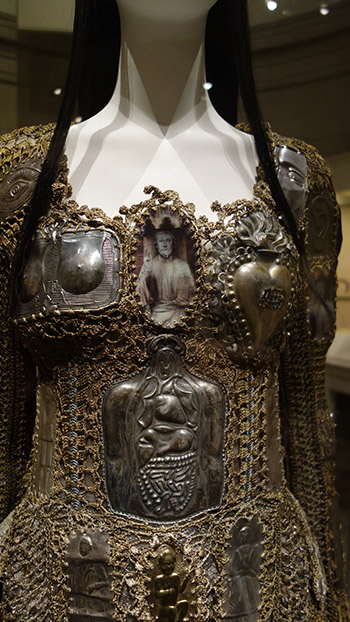
Jean Paul Gaultier designed this evening gown in the Met’s “Heavenly Bodies” exhibit, which included haute couture inspired by the Catholic tradition. Applied holograms, crystals and aluminum votives decorated the bodice. (Photo by E.A.R. Brown)
Cole, a fan of Met galas, said she’d seen Zendaya in the Joan of Arc dress by Versace, an Italian designer and businesswoman, and “had already fallen in love with it” before the course began. “It’s gorgeous, it’s incredible,” she said, “and it gave me an excuse to talk about Joan of Arc, who was called a heretic for claiming to speak for God, but became a Catholic saint.”
“I know Joan of Arc would have worn something more masculine, but Versace was confounding gender roles and bringing Joan back in armor — pretty armor with hip plating and a long, flowy chain mail dress,” said Cole. “She was using Joan as a symbol to criticize a church that doesn’t have a place for women a lot of the time and can be abusive to women and children.”
In addition to footage from the exhibit, Cole’s video, “She is Clothed in Strength and Dignity: Joan of Arc at the Met,” included scenes from the 1928 French silent film “The Passion of Joan of Arc.”
An upside of last week’s virtual conference for the Medieval Academy of America is that it was open to all, said Miller, not just to those who registered, and as a result, it exposed more people to the presenters’ work. With its webinars that were livestreamed both days, the gathering also could be a financially sustainable model for intellectual exchanges that require attendees to travel long distances, she added.
The downside was that, because of COVID-19, the number of presenters dropped because “all academics are overwhelmed with the demands of their own institutions as we go to remote instruction,” said Miller.
Despite the 2019-2020 school year’s challenges, Miller said her students “continue to be the brightest spot in my life, and that seminar was the best teaching experience in my whole career.”
Su’s and Cole’s essays, which informed their videos, soon will be published, along with those of their seminar classmates, in Clio’s Scroll, Berkeley’s undergraduate history journal.